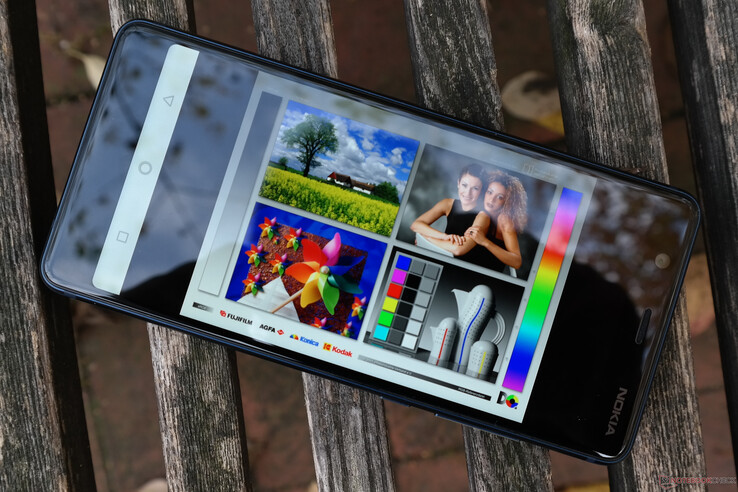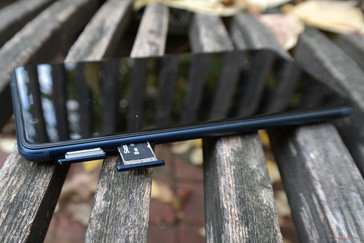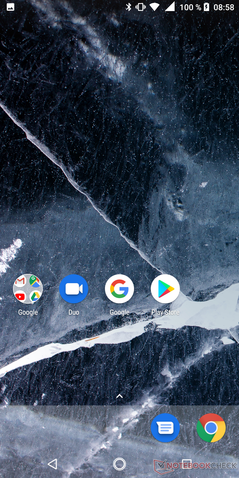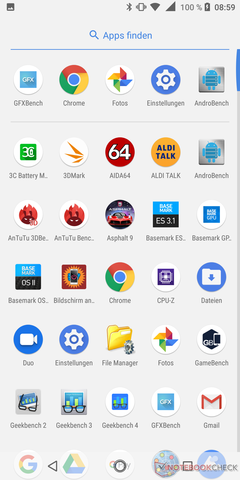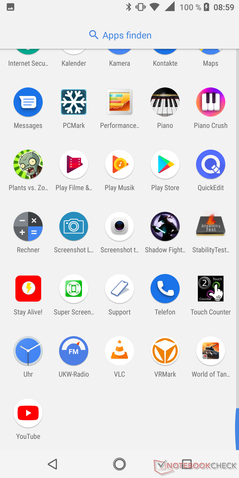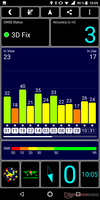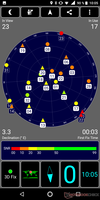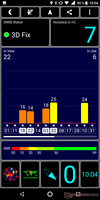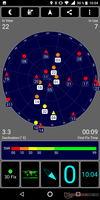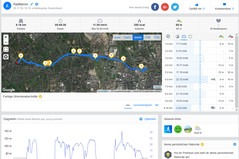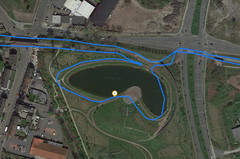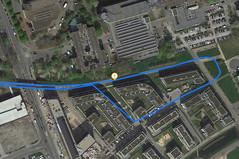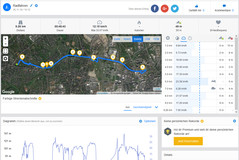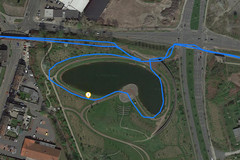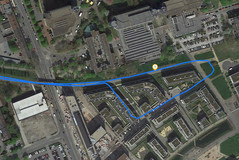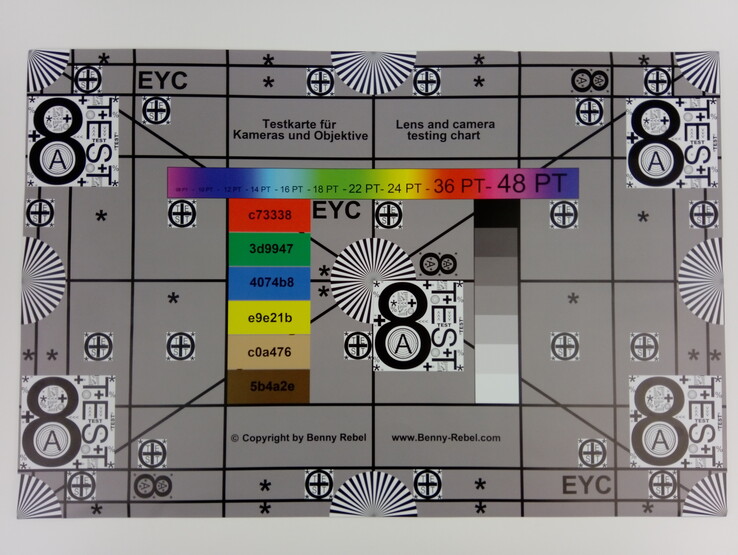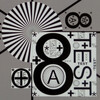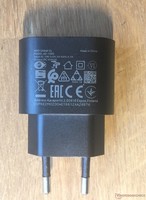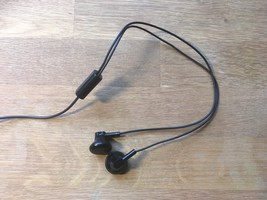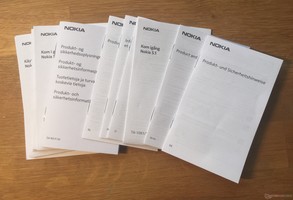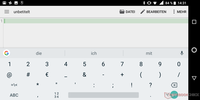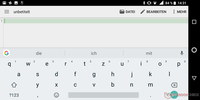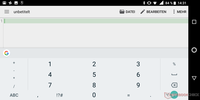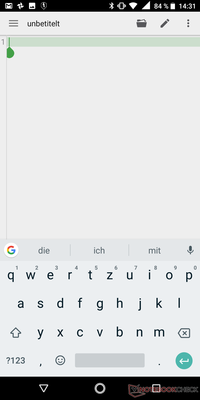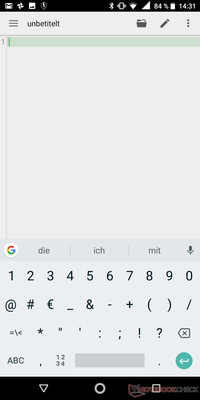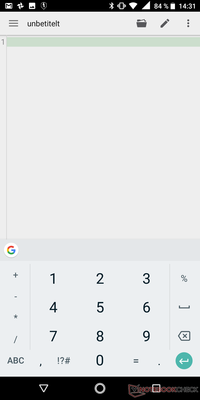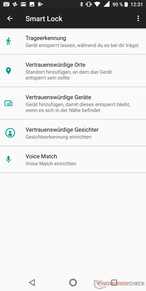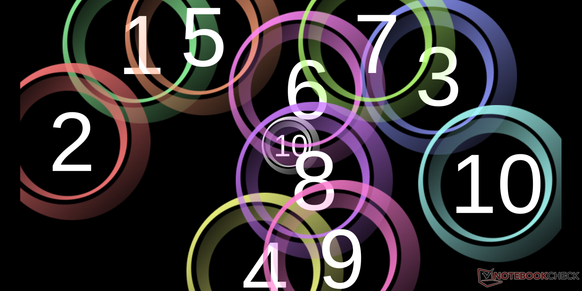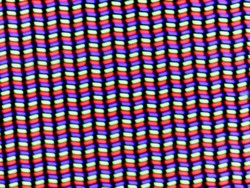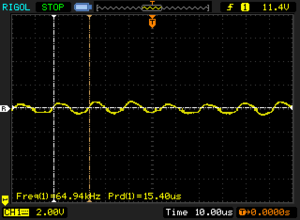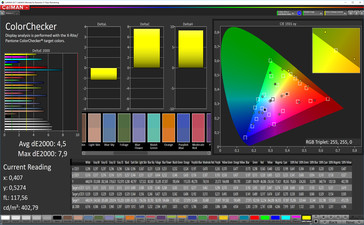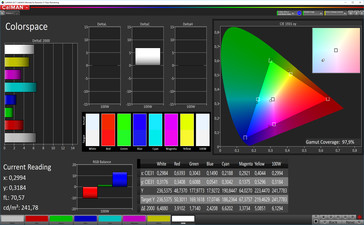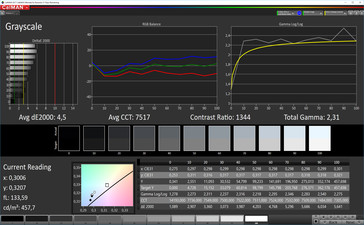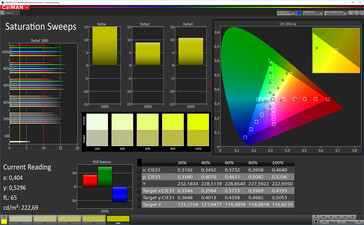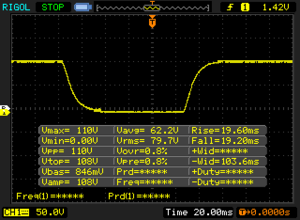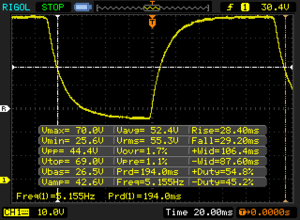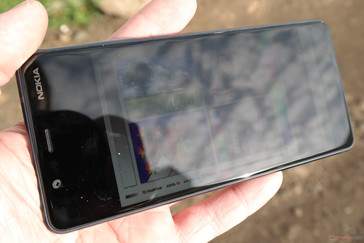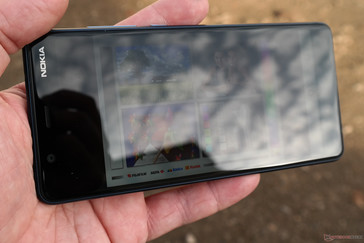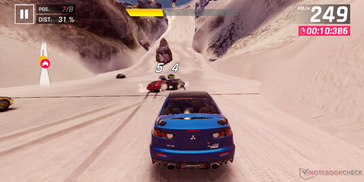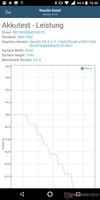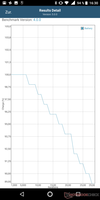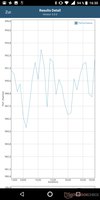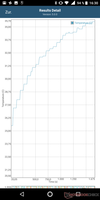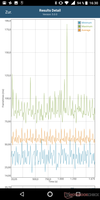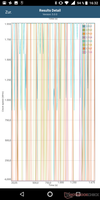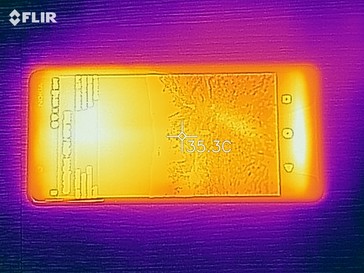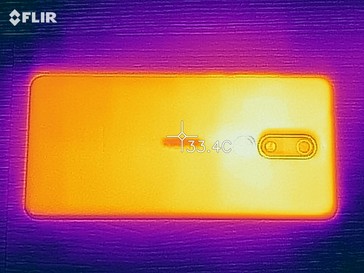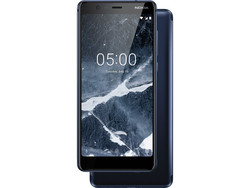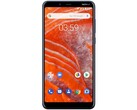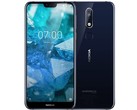Nokia 5.1 Smartphone Review

Buyers should not expect miracles from the Mediatek Helio P10 processor and the ARM Mali-T860 GPU. With 2 GB of RAM and 16 GB of internal storage space, the memory configuration is not exactly luxurious either. However, the camera features and the design seem to have hit the nail on the head. This is more than enough for a solid entry-level phone. Since they are often only used for casual games, a lower ranking processor is not as much of a hindrance. However, due to the fact that every phone doubles as an opportunistic digital camera, its quality is of great importance.
In this comparison, the Nokia device competes against the Moto G5s Plus representing Motorola, as well as the Redmi 6 Pro by Xiaomi. Furthermore, the Huawei Y7 and the Samsung Galaxy J6 are competitors as well.
Case - Nokia Phone with good Design
In the author's opinion, Nokia has once again done a great job in terms of looks. The workmanship does not show any weaknesses. The clearances are exemplary, making the phone appear as if it were made from one piece. The front is protected by Gorilla Glass 3. A camera sits at the top to the left and there is a speaker in the middle next to the Nokia branding to the right. On the bottom, there is an inexplicable, unnecessary black bezel that could have been extra screen space. The color options for the aluminum case are black, blue and copper and, as with the battery, they are unfortunately not replaceable as was the case with ancient Nokia phones. That said, it is very robust and was unimpressed by our attempts at twisting it. Due to the ratio of width and length, the smartphone appears long and elegant as opposed to thick and oversized. Its handling is comfortable thanks to the balanced weight distribution and the rounded-off edges. The port layout is standard. The volume control and the power button have been implemented in the form of robust metal versions, they have clear pressure points and a distinct acoustic feedback. Even if they can almost be considered smartphone standard at this point, the camera bump and fingerprint sensor on the back are less favorable however, since in the author's opinion, they always lead to blind searches involving trial and error. Although this could also be attributed to the habits of an Apple user.
Features - Spartan Nokia Cell Phone
In terms of external features, Nokia does not leave a lot to be desired. All of the ports have been neatly arranged in order to be easily accessible. To the right, there are high-quality volume control buttons and a power button. On the opposite side, there are not just one, but two trays that can be opened with the included SIM tool. They have room for two Nano SIM cards or a microSD card in the second tray. The included headset can be connected to the tried and true audio jack on the top edge of the device. On the bottom edge, there is a slightly outdated micro-USB connector that only supports USB 2.0 speeds.
What hides behind the glossy 1080x2160 resolution IPS screen with a pixel density of 439 DPI is less pleasant. It would be difficult to describe it as anything but mediocre. The Helio P10 processor from MediaTek, also known by its acronym MT6755, is currently ranked among the lowest in terms of performance and the ARM Mali T860 GPU matches it in that regard. It shares this kind of configuration with several Chinese phones in this price range. Although they tend to be equipped with more than enough RAM and a sufficient amount of internal storage space. Nokia cut corners here as well. Some benchmarking applications already fail to run with only 2 GB of RAM at their disposal. The operating system and the preinstalled apps take up almost half of the 16-GB internal storage space. In our tests, we were forced to insert an SD card and transfer some apps to it in order to be able to install everything we needed.
Since the storage space is limited and internet connections may be far away or too expensive, the Nokia 5.1 also supports classic radio reception.
Software
The Nokia mobile phone is labeled "Android One", which means that Google provides all of the updates and Nokia only has to release them. As a result, we are dealing with stock Android with the default launcher and without additional preinstalled software here. The installed Android version is 8.0 Oreo. The security updates are from October 5th 2018. In summary: You should not expect anything special, except for a relatively high, resulting security standard and a device that receives updates for longer than most Android devices. The Android device administration is active as well, allowing multiple users to set up on the smartphone independently from one another. Whether or not this is useful on a device as personal as a smartphone is another question.
Communication and GPS - Precise Geolocation with the Nokia 5
According to the manufacturer, the phone is equipped with dual-band 802.11a/b/g/n Wi-Fi. Our measurements confirmed this as well, with recorded speeds of up to 111 Mbit/s for both sending and receiving data to and from our reference router Linksys EA8500 just after 11.11.2018. It cannot be a coincidence! This puts the 5.1 on par with the other devices in this comparison. Only Huawei and Samsung lag behind here, barely managing to reach half of the Nokia's speeds. Overall, this places all three of them below the class average of around 200 Mbit/s.
If Wi-Fi is temporarily unavailable, the Nokia 5.1 can fall back on its LTE connection, through which it is able to send and receive data on all of the available frequencies in Germany, while also supporting VoLTE.
| Networking | |
| iperf3 transmit AX12 | |
| Xiaomi Redmi 6 Pro | |
| Nokia 5.1 | |
| Motorola Moto G5s Plus | |
| Huawei Y7 2018 | |
| Samsung Galaxy J6 2018 | |
| iperf3 receive AX12 | |
| Motorola Moto G5s Plus | |
| Xiaomi Redmi 6 Pro | |
| Nokia 5.1 | |
| Huawei Y7 2018 | |
| Samsung Galaxy J6 2018 | |
In order to test the cell phone's ability to rescue Hansel and Gretel from barren woods in Peter Jacksons 6-hour remake, we performed a synthetic test with "GPS Test" as well as a practical test in the form of a short bike ride through the urban jungle for an all-terrain test. On the bright side, the Nokia passed the simple test with a measured accuracy of within 3 meters (~10 ft). To achieve this, it uses satellites from the American GPS network and Russian GLONASS satellites. After leaving the outdoors, the locating capabilities' accuracy was reduced to within 7 meters (~23 ft), the satellite connections decreased and the connection broke, even just 1-2 meters (~3-7 ft) behind the window.
In the wild, the Nokia 5.1 competes against the professional navigation system Garmin Edge 500 and a quick glance at the results reveals that this is not a comparison between pebbles and breadcrumbs. On a route with a total distance of 10 km (~ 6.2 mi), there was a difference of 80 meters (~87 yd) between the two meterings. The exact route was fairly similar on both devices. Compared to the distinctly rounded-off curves on the Edge 500, the smartphone showed jagged edges, which can be attributed to less frequent position retrieval which is likely to be the main factor when it comes to the route's discrepancies. This can be considered a non-issue however. The Nokia 5 showed particularly weak results in the second picture around the bridge area which leads into a small avenue. Here, the lines very obviously deviated from the traversable route. Evidently, the vegetation interfered with the signal here. Even though Peter Jackson may choose another phone brand because of the tree weakness, there is no reason for anyone else not to enter a big city with this phone and rely on it to find your way out.
Telephony and Call Quality
Since this phone runs Android One, the use of the stock Android telephony app for making normal calls should come as no surprise. The smartphone quickly established a connection in our call test. The conversational partner could be understood sufficiently well. While the recording quality on the other end is free from static, it lacks frequencies and sounds tinny. Both treble and bass appear cutoff and unnatural. That said, distortions and ambient noises are filtered-out well.
The included headset is barely an upgrade. Its recordings are dull and have limited range, while still remaining barely intelligible. Ear candy is not to be expected here.
Cameras - Decent Cameras for a Nokia Phone
The cameras have been a cornerstone since Lumia times and the Finns have continued this tradition with the device at hand. In this case, the usually very apparent note referencing a Zeiss lens is absent and so is any further information about the installed sensor. Unlike with most phones nowadays, there is no dual-camera on the back. That said, the camera still does a good job, performs decently and with 16 megapixels, provides a sufficiently high resolution as well. Even though it cannot quite match them in terms of quality, the Nokia smartphone is able to go toe-to-toe with significantly more expensive competitors, such as the iPhone XR and the Huawei P20 Pro, particularly in terms of sharpness. In the second scene, the fur of the stuffed rabbit is captured precisely. The sharpness is slightly weaker in terms of depicting the patterns on the shirt, since it blurs them slightly which causes it to fall behind the single-lens reflex camera. However, the iPhone and the P20 in particular struggle with this as well.
The difference in quality between the candidates becomes very apparent in the dark. Here, the Nokia's representation of the scenery appears far darker than the other two smartphones'. The "Notebookcheck" label on the stuffed rabbit is barely recognizable. The P20 sets itself apart from its competition in that regard, since it shows the label clearly enough for it to be read without difficulty.
Unfortunately, the front camera is not able to match these good results. The photos are overexposed and the color accuracy is even lower than on the main camera. With a resolution of 8 megapixels it should still be powerful enough for a couple of Instagram bathroom selfies and Skype calls.
We conducted a more in-depth test on the sensor in the lab under controlled lighting conditions and a decreasing contrast towards the edges was the first thing we noticed. While the chart photo appears sharp in the overview, zooming in reveals a distinct lack in sharpness and chromatic noise. The weaknesses in the lab, particularly concerning sharpness, may have been caused by inaccurate focusing. However, the fact that the camera did not have any problems depicting the borage's delicate hairs or the ladybug-windmill from up close contradicts this theory.
The color comparison then confirms what the image comparison only hinted at: The color accuracy has some room for improvement. Red in particular drifts off into orange and the remaining colors appear overly bright as well. Barely any color is accurately depicted, a fact that is evident from the picture with the stuffed rabbit in scene 2, where the bluish stones shimmer like the Mariana Trench's deepest blue. That said, the overall composition still tends to appear coherent and rarely looks unnatural. Color inaccuracies are some of the easier things to fix with a good image editing program.
Accessories and Warranty - Nokia Service with 2-Year Warranty
Nokia includes a headset with their phone. While this is commendable, it does look a little cheap. The ear plugs appear very chunky and not very comfortable. The microphone part evidently follows this design scheme. A little attention to detail could have gone a long way here. Alternatively, the headset could have been foregone completely, since the audio quality matches its appearance.
The included charger and USB cable provide 10 W of power at 5V and 2A and they are able to fully charge the phone in 130 minutes. Aside from the mandatory SIM tool that is used to open the trays for the two SIM cards and the microSD card, the package includes numerous booklets. They consist of quick start guides as well as instructions for use and warranty information in every language from every imaginable and unimaginable country. This results in a lot of paper, much like emptying a mailbox without a "No advertisements, please!" sign.
That said, the small and compact package is commendable, even if the contents are less than satisfactory.
Once the right booklet in the right language has been dug up, it informs users that Nokia offers customers a 2-year warranty on top of the vendor's legally required guarantee. Please see our Guarantees, Return policies and Warranties FAQ for country-specific information.
Input Devices & Handling
The input devices of the Nokia 5 do not leave a lot to be desired: The touchscreen presents itself with responsive 10-point touch functionality. Fingers glide comfortably across the rounded-off screen. In our test with Real Piano, we detected no noticeable delay between the touch and the sound being played. The gyroscope works with subtle precision.
Google's GBoard serves as the keyboard app, offering advanced features for quickly changing the language and more.
The setup assistant presents the fingerprint sensor as an option for unlocking the phone and preventing unauthorized access. It is able to directly unlock the device from standby and works well, provided you manage to find it. Aside from the associated, mandatory PIN unlock method, Nokia offers a few unlocking options in the settings under "Smart Lock". They are tuned more towards a comfortable as opposed to a secure unlock.
Among them are the still relatively secure face recognition and Voice Match options.
The unlock through trusted locations and devices is less secure, since they no longer depend on an individual. The former has been implemented via GPS geolocation, the latter via contact with linked Bluetooth devices within reach. This allows for a quick unlock in the car, for example. The fact remains that other people may be present at trusted locations, potentially granting them full access to the phone without an additional layer of security. The technology called "carrying recognition" does not recognize who is carrying the smartphone, but rather that it is being carried and unlocks itself. The identity of the person carrying the phone is irrelevant here as well.
Display - Nokia 5.1 with gigantic Display
The installed 1080x2160 IPS display has an aspect ratio of 1:2 and a screen size of 5.5 inches, diagonally. This results in a pixel density of 439 DPI. However, the phone also has thick bezels both above and below the display. While the upper bezel contains the camera and the speaker, thus avoiding the controversial notch, the bottom black bar serves no obvious purpose. This is where the Android standard buttons were located on older generation phones - either as physical or virtual buttons. These elements have mostly disappeared due to the trend towards on-screen buttons, making the large black bezel on the bottom obsolete. The fact that Nokia still places it here may have technical reasons, but it primarily seems like wasted space that could have been used for more screen space.
The display shows some weaknesses in terms of brightness distribution as well. The brightest area of the display is the bottom left corner, the "darkest" one is on the opposite side, diagonally. In between them, values of 60 cd/m² can be measured. The brightness of just under 500 cd/m² is on par with the vast majority of currently available smartphones. Among the devices in the comparison, only the Xiaomi Redmi 6 Pro and the Moto G5s Plus were significantly brighter and the Samsung while having a better brightness distribution, had a fairly low total brightness of just under 300 cd/m². On average, the display of the Nokia 5.1 can compete with any of the other devices in this comparison.
| |||||||||||||||||||||||||
Brightness Distribution: 88 %
Center on Battery: 447 cd/m²
Contrast: 2794:1 (Black: 0.16 cd/m²)
ΔE ColorChecker Calman: 4.5 | ∀{0.5-29.43 Ø4.77}
ΔE Greyscale Calman: 4.5 | ∀{0.09-98 Ø5}
97.9% sRGB (Calman 2D)
Gamma: 2.31
CCT: 7517 K
| Nokia 5.1 IPS, 2160x1080, 5.5" | Xiaomi Redmi 6 Pro LCD IPS, 2280x1080, 5.8" | Motorola Moto G5s Plus IPS, 1920x1080, 5.5" | Huawei Y7 2018 IPS, 1440x720, 6" | Samsung Galaxy J6 2018 Super AMOLED, 1480x720, 5.6" | |
|---|---|---|---|---|---|
| Screen | -42% | -15% | -24% | 2% | |
| Brightness middle (cd/m²) | 447 | 554 24% | 512 15% | 393 -12% | 296 -34% |
| Brightness (cd/m²) | 451 | 538 19% | 500 11% | 365 -19% | 294 -35% |
| Brightness Distribution (%) | 88 | 91 3% | 90 2% | 85 -3% | 93 6% |
| Black Level * (cd/m²) | 0.16 | 0.61 -281% | 0.35 -119% | 0.29 -81% | |
| Contrast (:1) | 2794 | 908 -68% | 1463 -48% | 1355 -52% | |
| Colorchecker dE 2000 * | 4.5 | 4.86 -8% | 4.6 -2% | 5.28 -17% | 2.8 38% |
| Colorchecker dE 2000 max. * | 7.9 | 8.46 -7% | 7.6 4% | 9 -14% | 9.8 -24% |
| Greyscale dE 2000 * | 4.5 | 5.3 -18% | 3.8 16% | 4.2 7% | 1.9 58% |
| Gamma | 2.31 95% | 2.281 96% | 2.11 104% | 2.6 85% | 2.09 105% |
| CCT | 7517 86% | 7770 84% | 6952 93% | 7086 92% | 6398 102% |
* ... smaller is better
Screen Flickering / PWM (Pulse-Width Modulation)
| Screen flickering / PWM detected | 64.9 Hz | ≤ 10 % brightness setting | |
The display backlight flickers at 64.9 Hz (worst case, e.g., utilizing PWM) Flickering detected at a brightness setting of 10 % and below. There should be no flickering or PWM above this brightness setting. The frequency of 64.9 Hz is very low, so the flickering may cause eyestrain and headaches after extended use. In comparison: 53 % of all tested devices do not use PWM to dim the display. If PWM was detected, an average of 8084 (minimum: 5 - maximum: 343500) Hz was measured. | |||
Nokia has installed a fairly decent screen in terms of color accuracy. While an average DeltaE value of 4.5 is not exceptional, it is far above average. The grayscales showed a faint blue tint. The color saturation showed a few weaknesses as well. The Nokia phone achieved very good contrast ratio and black value results however. The use of very low frequency (65 Hz) pulse-width modulation at brightness settings below 10% is worth mentioning, since it may lead to visible flickering and increased eye strain as well as headaches.
Display Response Times
| ↔ Response Time Black to White | ||
|---|---|---|
| 38.8 ms ... rise ↗ and fall ↘ combined | ↗ 19.6 ms rise | |
| ↘ 19.2 ms fall | ||
| The screen shows slow response rates in our tests and will be unsatisfactory for gamers. In comparison, all tested devices range from 0.1 (minimum) to 240 (maximum) ms. » 96 % of all devices are better. This means that the measured response time is worse than the average of all tested devices (20.2 ms). | ||
| ↔ Response Time 50% Grey to 80% Grey | ||
| 57.6 ms ... rise ↗ and fall ↘ combined | ↗ 28.4 ms rise | |
| ↘ 29.2 ms fall | ||
| The screen shows slow response rates in our tests and will be unsatisfactory for gamers. In comparison, all tested devices range from 0.165 (minimum) to 636 (maximum) ms. » 94 % of all devices are better. This means that the measured response time is worse than the average of all tested devices (31.6 ms). | ||
Performance - Nokia Phone with mediocre Performance
The Helio P10 is a fairly sluggish chipset that is mostly found on older or low-priced smartphones. As mentioned earlier, you should not expect miracles from the CPU and the ARM Mali-T860 GPU. In combination with the low RAM configuration, the device quickly reached its limits in our performance tests. Several benchmarks did not finish running or did not start in the first place. This can probably be explained by the fact that the RAM was insufficient for 3D tests in particular and textures, etc. could not be fully loaded. The Antutu 7 benchmark, which is mainly useful for comparisons with the iOS platform, froze at 0% as well.
In the remaining benchmarks, the Nokia 5.1 fell between the Samsung J6 and the Huawei Y7. Both the Moto G5s Plus and the Redmi 6 Pro are slightly better equipped and tend to achieve better results across the board. The high resolution of the Nokia phone compared to Huawei's and Samsung's smartphones is of note however. It is advisable to compare GFXBench's offscreen values here, since they correspond to a set resolution as opposed to the onscreen test's which uses the native and significantly varying resolution of the respective device. On higher resolution displays, more pixels have to be rendered for every frame, causing the frame rate to drop in comparison. This caused the Nokia phone to outperform its Samsung and Huawei competitors in the GFXBench 2.7 offscreen test, while achieving poorer results than both of them in the onscreen test.
The larger scope PCMark test is interesting as well. Even though it places the 5.1 below its competition, the Nokia phone still performed better than the average of devices with the same chipset.
In conclusion: Despite the configuration being fairly mediocre, Nokia appears to have exhausted the chip's capabilities fully, resulting in an acceptable performance overall. When buying a phone in this price range, expectations should not be too high to begin with. The device manages chatting via WhatsApp, day-to-day use, checking mails and browsing the web just fine. The user interface also ran smoothly in our tests. If you wish to view demanding 3D games in their full glory, you should look at a higher-priced smartphone.
| PCMark for Android | |
| Work performance score (sort by value) | |
| Nokia 5.1 | |
| Xiaomi Redmi 6 Pro | |
| Motorola Moto G5s Plus | |
| Huawei Y7 2018 | |
| Samsung Galaxy J6 2018 | |
| Average Mediatek Helio P10 MT6755 (3069 - 4685, n=12) | |
| Work 2.0 performance score (sort by value) | |
| Nokia 5.1 | |
| Xiaomi Redmi 6 Pro | |
| Motorola Moto G5s Plus | |
| Huawei Y7 2018 | |
| Samsung Galaxy J6 2018 | |
| Average Mediatek Helio P10 MT6755 (3278 - 3405, n=3) | |
| Basemark GPU 1.1 | |
| 1920x1080 Vulkan Medium Offscreen (sort by value) | |
| Samsung Galaxy J6 2018 | |
| Vulkan Medium Native (sort by value) | |
| Samsung Galaxy J6 2018 | |
| AnTuTu v7 - Total Score (sort by value) | |
| Xiaomi Redmi 6 Pro | |
| Huawei Y7 2018 | |
| Samsung Galaxy J6 2018 | |
| Average Mediatek Helio P10 MT6755 (n=1) | |
| AnTuTu v6 - Total Score (sort by value) | |
| Nokia 5.1 | |
| Xiaomi Redmi 6 Pro | |
| Motorola Moto G5s Plus | |
| Huawei Y7 2018 | |
| Samsung Galaxy J6 2018 | |
| Average Mediatek Helio P10 MT6755 (44326 - 56750, n=12) | |
| VRMark - Amber Room (sort by value) | |
| Nokia 5.1 | |
| Samsung Galaxy J6 2018 | |
| Average Mediatek Helio P10 MT6755 (n=1) | |
Browsing the web is a use case for every smartphone, regardless of the price-range. Since hopefully no one buys this phone as a high-end gaming device, the speed of the web browser is of the utmost importance. This is where the Nokia device is actually able to shine, landing in the middle of the slower and faster devices in this comparison. Fortunately, it is once again ahead of smartphones with the same SoC. Only WebXPRT 2015 crashed beyond recovery during the HTML5 test.
| JetStream 1.1 - Total Score | |
| Motorola Moto G5s Plus (Chroem Version 62) | |
| Xiaomi Redmi 6 Pro (Chrome 68) | |
| Average Mediatek Helio P10 MT6755 (18.9 - 27.5, n=12) | |
| Nokia 5.1 (Chrome 70) | |
| Samsung Galaxy J6 2018 (Chrome 67.0.3396.87) | |
| Huawei Y7 2018 (Chrome 66) | |
| Octane V2 - Total Score | |
| Average of class Smartphone (2228 - 126661, n=194, last 2 years) | |
| Xiaomi Redmi 6 Pro (Chrome 68) | |
| Motorola Moto G5s Plus (Chroem Version 62) | |
| Nokia 5.1 (Chrome 70) | |
| Average Mediatek Helio P10 MT6755 (3163 - 4395, n=12) | |
| Samsung Galaxy J6 2018 (Chrome 67.0.3396.87) | |
| Huawei Y7 2018 (Chrome 66) | |
| Mozilla Kraken 1.1 - Total | |
| Huawei Y7 2018 (Chrome 66) | |
| Samsung Galaxy J6 2018 (Chrome 67.0.3396.87) | |
| Average Mediatek Helio P10 MT6755 (9346 - 23914, n=12) | |
| Nokia 5.1 (Chrome 70) | |
| Xiaomi Redmi 6 Pro (Chrome 68) | |
| Motorola Moto G5s Plus (Chroem Version 62) | |
| Average of class Smartphone (257 - 28190, n=154, last 2 years) | |
| WebXPRT 3 - Overall | |
| Average of class Smartphone (38 - 380, n=30, last 2 years) | |
| Xiaomi Redmi 6 Pro (Chrome 68) | |
| Samsung Galaxy J6 2018 (Chrome 67.0.3396.87) | |
| Nokia 5.1 (Chrome 70) | |
| Average Mediatek Helio P10 MT6755 (n=1) | |
| Huawei Y7 2018 (Chrome 66) | |
| WebXPRT 2015 - Overall | |
| Xiaomi Redmi 6 Pro (Chrome 68) | |
| Samsung Galaxy J6 2018 (Chrome 67.0.3396.87) | |
| Huawei Y7 2018 (Chrome 66) | |
| Average Mediatek Helio P10 MT6755 (66 - 72, n=3) | |
* ... smaller is better
The Nokia phone comes with 16 GB of internal storage space. This has already made things difficult during testing. However, Nokia gives users the ability to expand the storage with a microSD card of up to 128 GB, according to the manufacturer specifications. It is possible to format this memory as "internal storage" and apps can be transferred to it as well. The internal storage is not exceptionally fast. While the read speeds were still slightly above average, the write speeds were abysmal. Even the recorded write speeds of our reference microSD card, the Toshiba Exceria Pro M501, were significantly higher. Here, the competition's results were good across the board. Although the average scores for 16 GB eMMC memory are even worse, it is not exactly a good comparison since they still include ancient devices.
According to the manufacturer, the 5.1 does not support the exFAT file system. As a result, files larger than 4 GB cannot be stored on the SD card.
It is advisable for users to purchase a sufficiently fast memory card for permanent use with the smartphone.
| Nokia 5.1 | Xiaomi Redmi 6 Pro | Motorola Moto G5s Plus | Huawei Y7 2018 | Samsung Galaxy J6 2018 | Average 16 GB eMMC Flash | Average of class Smartphone | |
|---|---|---|---|---|---|---|---|
| AndroBench 3-5 | 363% | 166% | 47% | 68% | -1% | 3820% | |
| Sequential Read 256KB (MB/s) | 264.5 | 278.7 5% | 237.4 -10% | 256 -3% | 206.5 -22% | 164.5 ? -38% | 2235 ? 745% |
| Sequential Write 256KB (MB/s) | 25.96 | 212.9 720% | 75.7 192% | 71.5 175% | 100.5 287% | 43 ? 66% | 1871 ? 7107% |
| Random Read 4KB (MB/s) | 44.24 | 66.9 51% | 37.94 -14% | 38.8 -12% | 27.05 -39% | 21.7 ? -51% | 297 ? 571% |
| Random Write 4KB (MB/s) | 4.93 | 72.6 1373% | 44.89 811% | 9.5 93% | 12.37 151% | 8.08 ? 64% | 343 ? 6857% |
| Sequential Read 256KB SDCard (MB/s) | 72.6 ? | 83.5 ? 15% | 79.6 ? 10% | 85 17% | 81.8 ? 13% | 59.1 ? -19% | |
| Sequential Write 256KB SDCard (MB/s) | 55.5 ? | 62.2 ? 12% | 58.8 ? 6% | 61.5 11% | 65.8 ? 19% | 39.8 ? -28% |
Gaming - It runs Everything - barely
In order to test the gaming performance of the smartphone and the ARM Mali-T860 GPU in particular, we chose "Asphalt 9" and "World of Tanks Blitz" as benchmarks. The good news: Both games ran smoothly, although some visual refinements had to be turned off. Reflections and anti-aliasing appeared to be displayed in a significantly reduced capacity, even at higher graphics settings. It is possible that the chip is completely unable to render them.
World of Tanks Blitz
Emissions
Temperature
In our review, the Nokia 6.1 has already shown its very low heat development. The Nokia 5.1 was able to partially follow in its footsteps. Even though it does not run quite as cool as its big brother, the possibility of burns can be ruled out during proper use. Under load, the temperatures range from 1-2 °C higher than body temperature, which should be bearable. During idle, the heat development of around 30 °C (86 °F) is very low. The GFXBench load test did not show any drops in performance worth mentioning either. The performance constantly stayed above 98%.
(+) The maximum temperature on the upper side is 37.7 °C / 100 F, compared to the average of 35.2 °C / 95 F, ranging from 21.9 to 247 °C for the class Smartphone.
(+) The bottom heats up to a maximum of 35.9 °C / 97 F, compared to the average of 34 °C / 93 F
(+) In idle usage, the average temperature for the upper side is 30.7 °C / 87 F, compared to the device average of 32.9 °C / 91 F.
Speaker
While the installed mono speaker is able to produce a decent volume level, it does not get quite as loud as some of the Chinese ones. This is a good thing though, and prevents distorted playback at higher volumes from the start. According to our measurements, the playback quality of the treble is indirectly proportional to the bass quality. However, this is not a Nokia-specific smartphone speaker problem. In conclusion, the speakers achieved a result that was significantly below average. Although subjectively, they do not sound too badly.
The included headset barely improved this general impression. Their unappealing appearance aside, they are not exactly Hi-Fi equipment either. Due to this, it is particularly pleasing that Nokia still equips the device with a standard audio jack, which allows you to easily connect better headsets or speakers. Of course, this can also be achieved without audio jack through Bluetooth.
Nokia 5.1 audio analysis
(+) | speakers can play relatively loud (84.8 dB)
Bass 100 - 315 Hz
(-) | nearly no bass - on average 39.1% lower than median
(±) | linearity of bass is average (8.9% delta to prev. frequency)
Mids 400 - 2000 Hz
(±) | reduced mids - on average 6.1% lower than median
(±) | linearity of mids is average (7.1% delta to prev. frequency)
Highs 2 - 16 kHz
(+) | balanced highs - only 4.9% away from median
(+) | highs are linear (5% delta to prev. frequency)
Overall 100 - 16.000 Hz
(±) | linearity of overall sound is average (26.9% difference to median)
Compared to same class
» 69% of all tested devices in this class were better, 5% similar, 26% worse
» The best had a delta of 11%, average was 35%, worst was 134%
Compared to all devices tested
» 82% of all tested devices were better, 4% similar, 14% worse
» The best had a delta of 4%, average was 24%, worst was 134%
Motorola Moto G5s Plus audio analysis
(+) | speakers can play relatively loud (88.9 dB)
Bass 100 - 315 Hz
(-) | nearly no bass - on average 24.2% lower than median
(+) | bass is linear (6.9% delta to prev. frequency)
Mids 400 - 2000 Hz
(+) | balanced mids - only 3.9% away from median
(+) | mids are linear (6.4% delta to prev. frequency)
Highs 2 - 16 kHz
(±) | higher highs - on average 7.9% higher than median
(±) | linearity of highs is average (8% delta to prev. frequency)
Overall 100 - 16.000 Hz
(±) | linearity of overall sound is average (20.7% difference to median)
Compared to same class
» 36% of all tested devices in this class were better, 8% similar, 55% worse
» The best had a delta of 11%, average was 35%, worst was 134%
Compared to all devices tested
» 55% of all tested devices were better, 8% similar, 37% worse
» The best had a delta of 4%, average was 24%, worst was 134%
Battery Life - Disappointing
Energy Consumption
The Nokia phone fails to impress in terms of energy consumption. Its average performance is 17% below the class average and 4% below smartphones with the same processor. The competition passes Nokia by here as well, with the Samsung and the Motorola leading the charge and being 20% better than the Finns. Only the Xiaomi is even less economical with its energy reserves.
| Off / Standby | |
| Idle | |
| Load |
|
Key:
min: | |
| Nokia 5.1 2970 mAh | Xiaomi Redmi 6 Pro 4000 mAh | Motorola Moto G5s Plus 3000 mAh | Huawei Y7 2018 3000 mAh | Samsung Galaxy J6 2018 3000 mAh | Average Mediatek Helio P10 MT6755 | Average of class Smartphone | |
|---|---|---|---|---|---|---|---|
| Power Consumption | -11% | 23% | 9% | 22% | 4% | -7% | |
| Idle Minimum * (Watt) | 1.38 | 1.3 6% | 0.83 40% | 0.9 35% | 0.85 38% | 1.2 ? 13% | 0.847 ? 39% |
| Idle Average * (Watt) | 2.14 | 2.1 2% | 1.67 22% | 1.9 11% | 1.51 29% | 2.08 ? 3% | 1.448 ? 32% |
| Idle Maximum * (Watt) | 2.2 | 3.7 -68% | 1.85 16% | 2.3 -5% | 1.57 29% | 2.29 ? -4% | 1.633 ? 26% |
| Load Average * (Watt) | 4.21 | 4.5 -7% | 3.47 18% | 4.7 -12% | 4.21 -0% | 4.51 ? -7% | 6.96 ? -65% |
| Load Maximum * (Watt) | 6.81 | 6 12% | 5.41 21% | 5.7 16% | 5.88 14% | 5.91 ? 13% | 11.3 ? -66% |
* ... smaller is better
Battery Life
While the energy consumption was worse than the competition's, it was at least somewhat workable. The same cannot be said for the battery life. Here, the Nokia 5.1 falls far behind the competition. Since, apart from the Xiaomi, the devices in this comparison all contain a battery with an almost identical capacity, the results of this test are very fit for comparison. In Nokia's defense, it is worth mentioning that it has the highest resolution display out of all devices with a 3000 mAh battery. However, the Motorola Moto G5s Plus with the second largest display in the 3000 mAH battery-range serves as a counterexample, almost doubling the Nokia smartphone's battery life.
| Nokia 5.1 2970 mAh | Xiaomi Redmi 6 Pro 4000 mAh | Motorola Moto G5s Plus 3000 mAh | Huawei Y7 2018 3000 mAh | Samsung Galaxy J6 2018 3000 mAh | |
|---|---|---|---|---|---|
| Battery runtime | 75% | 91% | 25% | 48% | |
| Reader / Idle (h) | 17 | 29.4 73% | 24.9 46% | 21.8 28% | 24.9 46% |
| H.264 (h) | 10.5 | 20.2 92% | 11.5 10% | 14.5 38% | |
| WiFi v1.3 (h) | 8.7 | 14.5 67% | 16.2 86% | 10.4 20% | 11.8 36% |
| Load (h) | 2.9 | 4.9 69% | 7 141% | 4.1 41% | 5 72% |
Pros
Cons
Verdict - Perfect Entry-Level Phone
The Nokia 5.1 is designed as an entry-level smartphone for users with certain quality standards. At least, this is what it seems like. The phone is able to deliver in that regard. Buyers receive a low-priced phone that, at least from the outside, does not warrant criticism. The design is timeless and sleek and the use of the high-quality materials is well-conceived. The display is large, sufficiently bright and has a high resolution. The handling does not leave a lot to be desired either. Although the internals on the data sheet may appear disappointing, they are in line with the price/performance ratio and can thus be considered "cutting the right corners". The quality of the camera is above average, matching the needs of the target group. In short: This is the ideal entry-level smartphone if you prefer a solid phone at a 50 € (~$57) premium to a slightly better equipped, mid-range import device, which may come with certain quirks and a difficult warranty situation.
The perfect entry into the world of smartphones
Our biggest complaint is the poorly dimensioned internal storage. Here, 32 GB would have granted users more leeway. Then, of course, there is the battery life, which should have been far better.
Still, this smartphone is an excellent buy for anyone who wants to use their smartphone to make calls, send texts, check emails, look something up on the internet from time to time or occasionally play a non-demanding casual game. However, it is recommended to purchase a memory card and a power bank alongside it.
Nokia 5.1
- 10/31/2019 v7 (old)
Florian Schaar




